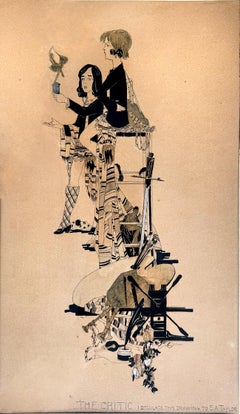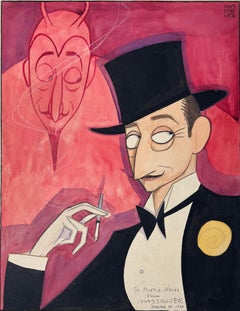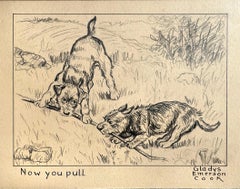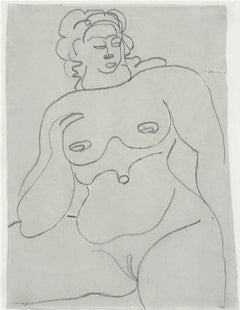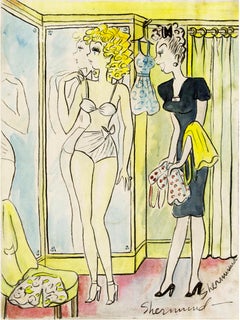Robert Funk Fine Art Drawings and Watercolor Paintings
1910s Figurative Drawings and Watercolors
Silver
1930s Art Nouveau Portrait Drawings and Watercolors
Watercolor, Ink, Illustration Board
1940s Academic Animal Drawings and Watercolors
Paper, Ink, Pencil
1920s Art Deco Nude Drawings and Watercolors
Paper, Pencil
1940s Feminist Figurative Drawings and Watercolors
Ink, Watercolor, Graphite, Paper
1940s American Modern Figurative Drawings and Watercolors
Watercolor, Board
1940s Impressionist Portrait Drawings and Watercolors
Watercolor, Pen
1940s Feminist Portrait Drawings and Watercolors
Watercolor
Early 1900s Victorian Figurative Drawings and Watercolors
Ink, Watercolor, Gouache, Board
1910s American Impressionist Figurative Drawings and Watercolors
India Ink, Watercolor, Board
Early 1900s American Modern Figurative Drawings and Watercolors
Paper, Watercolor
1950s Surrealist Figurative Drawings and Watercolors
Paper, Ink, Watercolor
Early 1900s Art Nouveau Nude Drawings and Watercolors
Paper, Watercolor, Gouache
1930s American Impressionist Figurative Drawings and Watercolors
India Ink, Board
1910s Art Deco Figurative Drawings and Watercolors
India Ink
1910s Cubist Figurative Drawings and Watercolors
Paper, India Ink, Color Pencil
1950s Figurative Drawings and Watercolors
Gouache, Ink, Paper
1940s American Modern Figurative Drawings and Watercolors
India Ink, Archival Paper
1930s Art Deco Figurative Drawings and Watercolors
India Ink, Watercolor, Illustration Board
1940s Art Deco Figurative Drawings and Watercolors
Watercolor, Gouache, Pencil, Paper
1960s American Realist Figurative Drawings and Watercolors
Ink, Pen
1920s Post-Impressionist Landscape Drawings and Watercolors
Paper, Crayon
1960s Surrealist Landscape Drawings and Watercolors
Tempera, Watercolor, Illustration Board, Pencil
1920s Art Nouveau Figurative Drawings and Watercolors
Gouache, Paper, Board
1910s Art Deco Figurative Drawings and Watercolors
Paper, Ink, Watercolor, Pencil, Gouache
1920s Figurative Drawings and Watercolors
Paper, Ink, Watercolor
1980s Contemporary Figurative Drawings and Watercolors
Paper, Ink, Watercolor, Gouache
1910s Academic Figurative Drawings and Watercolors
India Ink, Pencil, Graphite, Gouache
1950s Minimalist Abstract Drawings and Watercolors
Paper, Watercolor, Gouache, Pencil
1960s Conceptual Nude Drawings and Watercolors
Ink, Watercolor, Gouache, Illustration Board, Pencil
1960s Conceptual Figurative Drawings and Watercolors
Ink, Gouache, Illustration Board, Pen
2010s Conceptual Figurative Drawings and Watercolors
Paper, Watercolor, Ink
1960s Impressionist Nude Paintings
Watercolor, Illustration Board, Pencil
1960s Realist Figurative Paintings
Watercolor, Illustration Board, Pencil
1960s American Modern Nude Drawings and Watercolors
Watercolor, Illustration Board, Pencil, Gouache
1960s Outsider Art Figurative Drawings and Watercolors
Ink, Gouache, Archival Paper, Pen
1940s Contemporary Portrait Drawings and Watercolors
Ink, Board
1930s Figurative Drawings and Watercolors
Ink, Illustration Board, Gouache, Pencil
1940s American Realist Figurative Paintings
Watercolor, Illustration Board
1930s American Impressionist Animal Drawings and Watercolors
Paper, Crayon, Watercolor, Pencil
1990s Abstract Geometric Mixed Media
Paper, Magazine Paper, Pencil
1970s Modern Figurative Drawings and Watercolors
Watercolor
1970s Impressionist Figurative Drawings and Watercolors
Ink, Watercolor, Gouache
1970s American Modern Figurative Drawings and Watercolors
Watercolor, Pen, Pencil, Paper
1990s American Modern Figurative Drawings and Watercolors
Paper, Ink, Watercolor, Pen
1960s Expressionist Portrait Drawings and Watercolors
Paper, Watercolor, Pen
Early 1900s Pre-Raphaelite Figurative Drawings and Watercolors
Watercolor, Paper, Pencil
1920s Victorian Figurative Drawings and Watercolors
Watercolor, Gouache
Early 1900s Art Nouveau Figurative Drawings and Watercolors
Paper, Ink, Watercolor
Early 1900s Art Nouveau Figurative Drawings and Watercolors
Ink, Watercolor, Pencil
Early 1900s Romantic Figurative Drawings and Watercolors
Paper, Ink, Pen
1960s Surrealist Figurative Drawings and Watercolors
Mixed Media, Gouache, Board, Illustration Board
1890s Pre-Raphaelite Figurative Drawings and Watercolors
Paper, Ink, Pen
1960s American Realist Landscape Drawings and Watercolors
Ink, Gouache, Illustration Board
1950s Modern Portrait Drawings and Watercolors
Casein, Board, Pen
1980s American Modern Animal Drawings and Watercolors
Gouache
1920s American Realist Figurative Drawings and Watercolors
India Ink, Pencil
1940s Expressionist Figurative Drawings and Watercolors
Paper, Ink, Watercolor, Pen
1930s American Realist Landscape Drawings and Watercolors
Paper, Charcoal
1910s Victorian Portrait Drawings and Watercolors
Ink, Illustration Board, Pen
